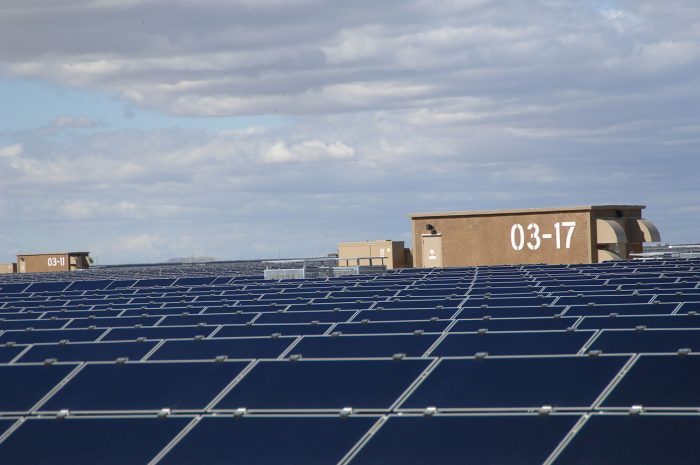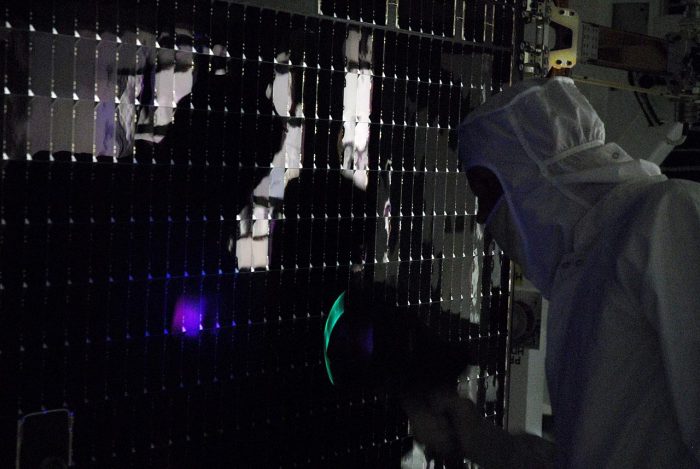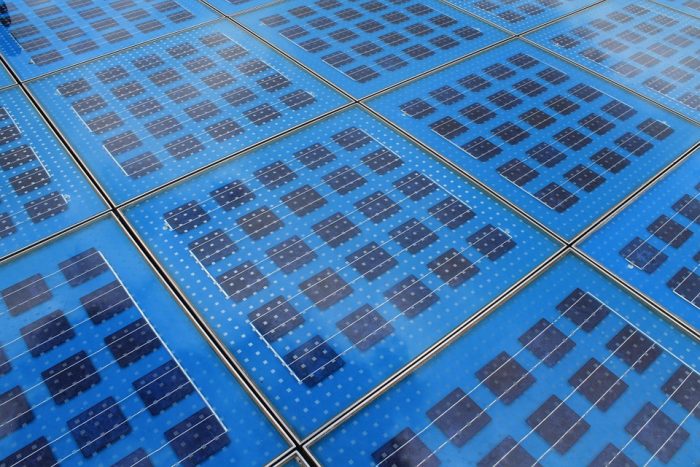
Scientists have recently identified a key structural problem in solar panels that reduced their efficiency. The silicon used to create solar panels had a defect in them which had previously gone undetected. This defect could potentially be behind a phenomenon known as Light-Induced Degradation (LID), where solar cells see a 2% drop in efficiency after their first few hours of usage.
Light-induced degradation is a phenomenon that dramatically affects the energy harnessing potential of multicrystalline silicon solar cells created with aluminum oxide. The loss in efficiency is between 1% to 3% overall, and the loss occurs after the very first hours of sunlight exposure for the solar cells.
Why is it a big deal that solar panels are losing 2% of their efficiency? As reported by ScienceAlert, Tony Peaker of the University of Manchester explains that although 2% total loss may not seem like a large amount, it’s very significant.

Photo: Topaz Solar Farm – a massive 550 MW capacity solar power plant in San Luis Obispo County, California (https://commons.wikimedia.org/w/index.php?curid=36895377), By Pacific Southwest Region from Sacramento, US – Solar Panels at Topaz Solar 5, via Wikimedia Commons, Public Domain
“Consider that these solar panels are now responsible for delivering a large and exponentially growing fraction of the world’s total energy needs, and it’s a significant loss of electricity generating capacity,” explained Peaker.
The Need To Boost Solar Efficiency
When the increasing number of solar panels installed at solar farms around the globe is accounted for, loss from LID is a substantial number of gigawatts that must be made up for by non-renewable energy sources. Previous estimates have placed the energy loss from LID around the amount of energy that can be harnessed by the UK’s 15 nuclear power plants combined.
The solar energy sector is growing dramatically around the world. As reported by CleanTechnica, the United States installed around 1.7 gigawatts of solar power capacity in the third quarter of 2018 alone, which will provide enough energy to power around 11.3 million homes. Although this represents a slight decrease from previous years, the overall trend is still one of growth. The Solar Energy Industries Association estimated that the total photovoltaic capacity of the US will double over the next five years. Latin America, Europe, China, and the Middle East are also investing heavily in solar technology. China became the first country to surpass 100 GW of installed solar capacity in 2017, and its currently the world’s largest producer of solar power.

Photo: A test of a triple-junction gallium arsenide solar cell array. (https://commons.wikimedia.org/w/index.php?curid=2205133) By NASA/George Shelton – https://mediaarchive.ksc.nasa.gov/, via Wikimedia Commons, Public Domain
Despite the rapid growth of the solar industry, most solar panels only achieve approximately 20% efficiency, or to put that another way, 200W of electrical power can be harnessed out of every kilowatt of equivalent sunlight. When viewed in this context, a 2% efficiency gain is a gain of 1/10th of the current max efficiency. Solar cells are theoretically capped a maximum efficiency of about 33%. This limit is referred to as the Shockley-Queisser limit, or the Detailed Balance Limit. For any single junction solar cell, it is theoretically impossible to harness more than 33% of the total solar energy that hits it.
This problem can be overcome somewhat by having solar cells arrayed in multiple layers, so that the lower layers of the solar array can capture some of the lost energy. Multi-layered solar arrays can potentially gather much more energy than a single solar cell, so an increase of 2% efficiency in every layer can be dramatic when the cascading effects of multi-layer solar cells are calculated. Currently, the best cost-benefit ratio for many solar applications is often just a single layered cell, but engineering advances could make multi-layered solar cells much more economically viable.
Identifying The Silicon Defect
Peaker explained that in recent years, a lot of money and time has been poured into trying to increase the efficiency of solar cells. This is due in part to the growing environmental and financial impact of solar cells. Yet despite all the research on solar cells, until now the problem remained unsolved. For the almost four decades research has been conducted on solar cells, the defect in silicon chips when unnoticed, despite the publishing of 270 research papers on the topic.
The breakthrough was made when an optical/electrical technique referred to as deep-level transient spectroscopy (or DLTS) was utilized to find structural abnormalities in the silicon. The DLTS analysis found that electrons were trapped in certain pockets of the silicon solar cell. As the solar cells are hit with sunlight and the electronic charge builds up in them, the electrons are blocked in specific areas, ultimately reducing the efficiency of the panels. This defect went unnoticed because it doesn’t manifest itself unless the solar panel is heated.
Now that the defect has been identified, it will be an engineering challenge to create a fix for the problem and improve the efficiency of the cells, explains Iain Crowe as reported by Science Alert, also from the University of Manchester and one of the researchers on the project.

Photo: pruzi via Pixabay (https://pixabay.com/photos/photovoltaic-solar-cells-ground-286025/), Pixabay License(https://pixabay.com/service/license/)
In addition to discovering that the defect in the silicon structures of the solar cells, the researchers also discovered another quirk of silicon solar cells. Apparently, silicon cells of higher quality have a longer lifetime overall. The electrons responsible for transporting the photon energy don’t get trapped as easily, which supports the hypothesis that the silicon traps are responsible for the drop off in efficiency. The degradation could be ameliorated by heating the material in a dark environment, which effectively removes the traps from the silicon material.
Other Advances In Solar Technology
The University of Manchester study was not the only recent study to potentially improve solar panel efficiency. A study conducted by a PhD student from Loughborough University helped understand why combining selenium and cadmium telluride could dramatically improve the efficiency of certain solar panels. Although most solar panels are made out of silicon, a new type of solar panel created from cadmium telluride, a different semiconducting material, has recently attracted interest and gained in popularity.
Until the study was conducted by Tom Fiducia, Ph.D. research student at the Center for Renewable Energy Systems Technology, it wasn’t clear why selenium improved the efficiency of cadmium telluride based panels. As reported by Phys, Fiducia’s study found that selenium functions to combat some of the atomic-scale defects in cadmium telluride based solar panels that reduce their efficiency. The study explains that when the electrons are generated by the solar cells hitting the solar panel, the selenium makes the electrons less likely to become trapped within the panel and lost at the location of certain defects.
The discovery was made when Fiducia and the rest of the research team measured how much light was emitted by the combined selenium-cadmium telluride panels. Because the selenium isn’t evenly distributed throughout the panels, rather it exists in discrete regions, the researchers were able to compare the ‘luminescence’ from areas containing selenium to areas not containing selenium.
As Fiducia explained to Phys, “While it seems counter-intuitive, good solar cell material that is defect-free is very efficient at emitting light, and so luminesces strongly.”
The team took a high-resolution map of a selenium solar cell and compared different regions of the cell. Areas which contained selenium in high amounts were much brighter, had much more luminance, than regions that didn’t have selenium and were pure cadmium telluride. Fiducia hopes that the discovery will enable researchers and engineers to improve the efficiency of solar cells around the globe. Fiducia explained that one way to increase the efficiency of selenium-cadmium telluride panels is simply to either increase the amount of selenium in the panels or to alter the distribution of the selenium within panels. Doing so would hopefully make harnessing electricity from sunlight even cheaper and have a positive effect on regions that use the panels.
Other scientists have turned to nature to observations of nature for ideas on how to improve the efficiency of solar panels. A type of fluorescent algae is able to capture almost 95% of available light, a marked improvement over the efficiency of even the best solar cells we have. By studying cyanobacteria and red algae, scientists have been able to come up with some ideas that may improve the efficiency of solar cells.
The organisms in question are covered in many light-capturing antennae called phycobilisomes, and the study examined these structures to determine their composition. The study found that each for these antennae was comprised of four different kinds of “building blocks”, and by working in concert with one another they are able to capture the vast majority of the light that reaches them. Now that the distinct modules that let cyanobacteria or red algae absorb light to such an amazing extent have been identified, scientists can now apply the knowledge to improve the performance of current solar cells.
Aneika Leney, one of the researchers associated with the research project at the University of Birmingham, explains that microalgae can do things much better than products created by even the best engineers, so why not study them to learn their secrets?
“By applying this knowledge, we can start to make real progress towards adapting these systems for use in solar panels,” said Leney to the University of Birmingham news.








